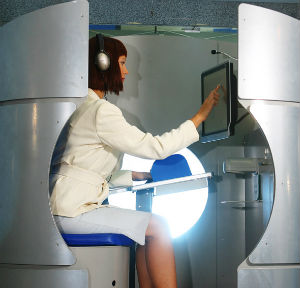Civil Aviation has been a popular target for terrorists for many years. Attacks on planes have a high and dramatic media profile and in most attack scenarios, the consequences can result in a very high death toll. New developments in biometrics try to provide airports with better situational awareness and investigation capabilities.
Civil Aviation has been a popular target for terrorists for many years. Attacks on planes have a high and dramatic media profile and in most attack scenarios, the consequences can result in a very high death toll. New developments in biometrics try to provide airports with better situational awareness and investigation capabilities.
Face Capture and Recognition
Facial recognition is a technology that garners much interest from airports. "Face recognition is coming up more and more, if you have good camera placement and camera choice, you can capture a high percentage of the faces passing through the airport. By capturing the faces, you can then compare them to a watch list of people that are already known to be high risk or use that database of captured faces as a resource that can be used to discover if a new person of interest has been present within the airport," explained Bill Flind, CEO of U.K.-based Ipsotek.
Most incidents don't happen randomly, planning an attack includes a lot of intelligence gathering and logistics planning in the stages prior to an attack. In this case, a system that effectively captures faces and stores them can be used by security services to check if a suspect has been at the airport before and what he was doing there. Face recognition is effective in places where people face a certain direction – passport control, passing through doors or baggage claims. But is it practical to capture the faces of everyone passing through an airport?
"To capture a high percentage isn't easy and requires a lot of design and investment in storage, cameras and software. We also recommend combining face recognition capability with the use of our scenario-based video analytics to detect certain general behaviors (e.g., someone entering a restricted area, tailgating or loitering) and to act as a trigger for tracking the individual concerned,” explained Flind. The faces can then be compared to existing faces in a database "watch list." If there is a new face, the operator can enroll the face into the system. "If the system identifies a suspect, we can tie it to the overview camera and see the context of the scene, who they were with, where they went, etc.," he continued.
Nonetheless, it is important to remember that facial recognition, especially in crowded conditions, still face many challenges such as poor illumination, items covering the face and visual blocking caused by other people, all of which might influence reliability.
New Biometric Technologies for Airports
Several companies are developing biometric identification as a way to assist in detecting hostile intent or provide faster clearance at

airports and other controlled areas.
Israel-based Suspect Detection Systems (SDS) has developed an automated solution for screening, interviewing, and detecting threats. The solution involves the use of palm reader and a camera that can monitor parameters like temperature, skin conductivity, sweating, etc. Using principles similar to the ones used in lie detectors, it shows the examinees a series of questions and monitors their responses. In case the system detects any abnormal behavior, the person is then referred to a human investigator for further clarification.
Another Israeli company FST Biometrics is developing a type of biometric identification system that will be able to identify people from a distance and while walking – in Motion Identification technology. Unlike other systems that looks for potential suspects, this requires preliminary registration. Thus, in an airport scenario, the system is more suitable for employees or frequent fliers. Once a passenger is registered in the system, it can be used to facilitate faster check-in and movement through the airport, alleviating some of the burden from security personnel and giving passengers a better, faster travel experience.
Biometric solutions are complicated, they require registration and consent; and are also subject to many other concerns such as data storage and privacy. However, they have the potential to bring new directions to airport security.